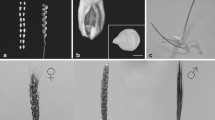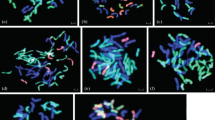Summary
Intergeneric hybridization between four common wheat cultivars, Triticum aestivum L. cultivars Chinese Spring, Norin 12, Norin 61, and Shinchunaga, and cultivated barley, Hordeum vulgare L. cultivars Betzes, Nyugoruden, Harunanijou, and Kinai 5 were carried out in a greenhouse under 15 – 20 °C and long-day (15 h) photoperiod conditions. Two days prior to pollination, a 100 mg/1 2,4-D solution was injected into wheat stems. Among wheat cultivars, Norin 12, Norin 61, and Shinchunaga showed higher crossabilities than that of Chinese Spring, suggesting the presence of crossability gene(s) other than the kr system of Chinese Spring. Variation was also found among the barley cultivars as male parents. Betzes barley showed the highest crossability with wheat. Thus, the cross Norin 12×Betzes showed the highest crossability (8.25%), followed by Norin 61 ×Betzes (6.04%), Shinchunaga×Betzes (5.00%), and Shinchunaga×Kinai 5 (5.00%). The embryos were rescued by culture at 15–20 days after pollination. Seventyfour plants were obtained from 82 embryos. The morphology of the hybrid plants resembled that of wheat parents. Among 60 seedlings observed, 28 had 28 chromosomes, 8 had 21, 23 had aneuploid numbers of chromosomes (22–27), and 1 had 29 chromosomes. About half of the aneuploid hybrids showed mosaicism for chromosome number. By analyzing five isozyme markers of barley chromosomes, the chromosome constitutions of the aneuploid hybrids were determined. Barley chromosomes 1 and 5 were found to be preferentially eliminated in the hybrids, while chromosomes 2 and 4 were eliminated infrequently. The conditions and genetic factors for high crossability and the tendency of barley chromosome elimination are discussed.
Similar content being viewed by others
References
Barclay IR (1975) High frequencies of haploid production in wheat (Triticum aestivum) by chromosome elimination. Nature 256:410–411
Barcley IR (1976) A study of the genetics and mechanism of genome and chromosome loss in cereals. PhD thesis, Cambridge University, UK
Benito C, Figueiras AM, Gonzalez-Jean MT, Salinas J (1985) Biochemical evidence of homoeology between wheat and barley chromosomes. Z Pflanzenzuecht 94:307–320
Bennett MD, Finch RA, Barclay IR (1976) The time rate and mechanism of chromosome elimination in Hordeum hybrids. Chromosoma 54:175–200
Bothmer R von, Flink J, Linde-Laursen I (1986) Development and meiosis of three interspecific hybrids with cultivated barley (Hordeum vulgare L.). Z Pflanzenzuecht 96:107–114
Chen X, Du ZH, Zhang WX, Yin FY, Xu HJ (1984) The barley×wheat crosses and their offspring plants. Acta Agron Sin 10:65–71
Chu C, Wang C, Sun C, Hsu C, Yin K, Chu C (1975) Establishment of an efficient medium for anther culture of rice through comparative experiments on the nitrogen sources. Sci Sin 18:659–668
Falk DE, Kasha KJ (1981) Comparison of the crossability of rye (S. cereale) and Hordeum bulbosum onto wheat (T. aestivum). Can J Genet Cytol 23:81–88
Falk DE, Kasha KJ (1982) A study of hormones on cross-incompatibility of wheat with rye and Hordeum bulbosum. Cereal Res Comm 10:233–234
Fedak G (1977) Increased homoeologous chromosome pairing in Hordeum vulgare×Triticum aestivum hybrids. Nature 266:529–530
Fedak G (1980) Production, morphology, and meiosis of reciprocal barley-wheat hybrids. Can J Genet Cytol 22:117–123
Fedak G, Jui PY (1982) Chromosomes of ‘Chinese Spring’ wheat carrying genes for crossability with ‘Betzes’ barley. Can J Genet Cytol 24:227–233
Fukuyama T (1987) Genetic control of chromosome elimination in interspecific hybrids between Hordeum bulbosum and H. vulgare. In: Barley genetics V (Proc 5th Int Barley Genet Symp, Okayama), pp 317–324
Hart GE, Islam AKMR, Shepherd KW (1980) Use of isozymes as chromosome markers in the isolation and characterization of wheat-barley chromosome addition lines. Genet Res 36:311–325
Inagaki M (1986) Crossability of Japanese wheat cultivars with Hordeum bulbosum L. Jpn J Breed 36:363–370
Islam AKMR, Shepherd KW, Sparrow DHB (1975) Addition of individual barley chromosomes to wheat. In: Barley genetics III (Proc 3rd Int Barley Genet Symp, Garching), pp 260–270
Islam AKMR, Shepherd KW, Sparrow DHB (1978) Production and characterization of wheat-barley addition lines. In: Proc 5th Int Wheat Genet Symp, New Delhi, pp 365–371
Islam AKMR, Shepherd KW, Sparrow DHB (1981) Isolationand characterization of euplasmic wheat-barley chromosome addition lines. Heredity 46:161–174
Kasha KJ, Kao KN (1970) High frequency haploid production in barley (Hordeum vulgare L.). Nature 225:874–876
Kasha KJ, Subrahmanyam NC (1973) Selective chromosomal elimination during haploid formation in barley following hybridization. Chromosoma 42:111–125
Koba T, Shimada T, Niizeki H (1987) Production of wheat×barley hybrid. Jpn J Breed 37 [Suppl 2]: 162–163 (Abstract)
Krowlow KD (1970) Untersuchungen über die Kreuzbarkeit zwischen Weizen und Roggen. Z Pflanzenzuecht 64:44–72
Kruse A (1973) Hordeum×Triticum hybrids. Hereditas 73:157–161
Larter E, Chaubey C (1965) Use of exogenous growth substances in promoting pollen tube growth and fertilization in barley-rye crosses. Can J Genet Cytol 7:511–518
Lein A (1943) Die genetische Grundlage der Kreuzbarkeit zwischen Weizen und Roggen. Z Indukt Abstamm Vererbungsl 81:28–61
Linde-Laursen I, Bothmer R von (1986) Giemsa C-banding in two polyploid, South American Hordeum species, H. tetraploidum and H. lechleri, and their aneuploid hybrids with H. vulgare. Hereditas 105:171–177
Linde-Laursen I, Bothmer R von (1988) Elimination and duplication of particular Hordeum vulgare chromosomes in aneuploid interspecific Hordeum hybrids. Theor Appl Genet 76:897–908
Noda K (1984) Chromosome elimination and malfunction of spindle mechanism at meiosis in interspecific hybrids between barley and its wild species H. bulbosum. Seiken Ziho 32:39–44
Pickering RA, Morgan PW (1985) The influence of temperature on chromosome elimination during embryo development in crosses involving Hordeum spp., wheat (Triticum aestivum L.), and rye (Secale cereale E.). Theor Appl Genet 70:199–206
Powling A, Islam AKMR, Shepherd KW (1981) Isozymes in wheat-barley hybrid derivative lines. Biochem Genet 19:237–253
Riley R, Chapman V (1967) The inheritance in wheat of crossability with rye. Genet Res 9:259–267
Saunas J, Figueiras AM, Gonzales-Jean MT, Benito C (1985) Chromosomal location of isozyme markers in wheat-barley addition lines. Theor Appl Genet 70:192–198
Sasaki M (1987) Triticale cytogenetics and breeding. Jpn J Breed 37 [Suppl 1]:2–5
Sethi GS, Finch RA, Miller TE (1986) A bread wheat (Triticum aestivum)×cultivated barley (Hordeum vulgare) hybrid with homoeologous chromosome pairing. Can J Genet Cytol 28:777–782
Shimada T, Koba T, Otani M, Niizeki H (1987) Morphology, meiosis, and in vitro propagation of barley-wheat hybrids. In: Barley genetics V (Proc 5th Int Barley Genet Symp, Okayama), pp 343–350
Snape J, Chapman V, Moss J, Blanchard CE, Miller TE (1979) The crossabilities of wheat varieties with Hordeum bulbosum. Heredity 42:291–298
Taira T, Larter EN (1977) Effects of ɛ-amino-η-caproic acid and l-lysine on the development of hybrid embryos of triticale (x Triticosecale). Can J Bot 55:2330–2334
Thomas JB, Mujeeb KA, Rodriguez R, Bates ES (1977) Baley×wheat hybrids. Cereal Res Commun 5:181–188
Tsumura Y, Uchida K, Ohba K (1989) Genetic control of isozyme variation in needle tissues of Cryptomenia japanica. J Hered 80:291–297
Xue S, Zhang Y, Xu J (1988) Morphology and cytology of the fertile alloplasmist Hordeum vulgare (L.) x Triticum aestivum (L.). Scientia Agricultura Sinica 21:46–50
Yasuda S (1977) Linkage of the barley earliness gene ea k and its pleiotropic effects under different growth conditions. BerOhara Inst Eandwirtsch Biol 17: 15–28
Author information
Authors and Affiliations
Additional information
Communicated by K. Tsunewaki
Rights and permissions
About this article
Cite this article
Koba, T., Handa, T. & Shimada, T. Efficient production of wheat-barley hybrids and preferential elimination of barley chromosomes. Theoret. Appl. Genetics 81, 285–292 (1991). https://doi.org/10.1007/BF00228665
Received:
Accepted:
Issue Date:
DOI: https://doi.org/10.1007/BF00228665




